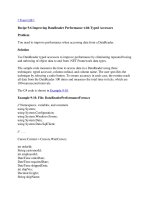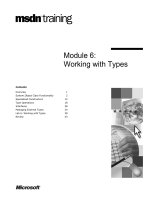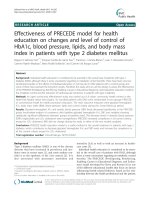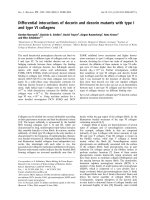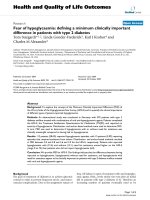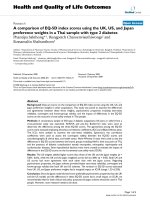Thinking with type
Bạn đang xem bản rút gọn của tài liệu. Xem và tải ngay bản đầy đủ của tài liệu tại đây (5.07 MB, 37 trang )
Typography is what language looks like.
princeton architectural press
.
new york
a critical guide
for designers,
writers, editors
& students
ellen lupton
type
thinking
with
Published by
Princeton Architectural Press
37 East Seventh Street
New York, New York 10003
For a free catalog of books, call 1.800.722.6657.
Visit our web site at www.papress.com.
© 2004, 2010 Princeton Architectural Press
Princeton Architectural Press
All rights reserved
Printed and bound in China
14 13 12 11 10 5 4 3 2 1 Second, revised and
expanded edition
No part of this book may be used or reproduced in
any manner without written permission from the
publisher, except in the context of reviews.
Every reasonable attempt has been made to identify
owners of copyright. Errors or omissions will be
corrected in subsequent editions.
Library of Congress Cataloging-in-Publication Data
Lupton, Ellen.
Thinking with type : a critical guide for designers,
writers, editors, & students / Ellen Lupton. — 2nd
rev. and expanded ed.
p. cm.
Includes bibliographical references and index.
ISBN 978-1-56898-969-3 (alk. paper)
1. Graphic design (Typography) 2. Type and
type-founding. I. Title.
Z246.L87 2010
686.2’2—dc22
2010005389
7
9
10 letter
14 Humanism and the Body
16 Enlightenment and Abstraction
22 Monster Fonts
26 Reform and Revolution
28 Type as Program
30 Type as Narrative
32 Back to Work
36 Anatomy
38 Size
42 Scale
46 Type Classification
48 Type Families
50 Superfamilies
52 Capitals and Small Capitals
54 Mixing Typefaces
56 Numerals
58 Punctuation
60 Ornaments
64 Lettering
68 Logotypes and Branding
72 Typefaces on Screen
74 Bitmap Typefaces
76 Typeface Design
78 Exercise: Modular Letterforms
80 Font Formats
82 Font Licensing
Ellen Lupton
First edition: Mark Lamster
Second edition: Nicola Bednarek
Jennifer Tobias and Ellen Lupton
Paintings by Ellen Lupton
Dan Meyers
Scala Pro, designed by Martin Majoor
Thesis, designed by Luc(as) de Groot
Nettie Aljian, Bree Anne Apperley, Sara Bader, Janet Behning,
Becca Casbon, Carina Cha, Tom Cho, Penny (Yuen Pik) Chu,
Carolyn Deuschle, Russell Fernandez, Pete Fitzpatrick,
Wendy Fuller, Jan Haux, Linda Lee, Laurie Manfra, John Myers,
Katharine Myers, Steve Royal, Dan Simon, Andrew Stepanian,
Jennifer Thompson, Paul Wagner, Joe Weston, and Deb Wood
of Princeton Architectural Press
—Kevin C. Lippert, publisher
This project was produced with editorial support from the
Center for Design Thinking, Maryland Institute College of Art.
—essential texts on design.
Also available in this series:
D.I.Y. Design It Yourself, Ellen Lupton, 978-1-56898-552-7
Elements of Design, Gail Greet Hannah, 978-1-56898-329-5
Geometry of Design, Kimberly Elam, 978-1-56898-249-6
Graphic Design Theory, Helen Armstrong, 978-1-56898-772-9
Grid Systems, Kimberly Elam, 978-1-56898-465-0
Lettering & Type, Bruce Willen, Nolen Strals, 978-1-56898-765-1
Indie Publishing, Ellen Lupton, 978-1-56898-760-6
Typographic Systems, Kimberly Elam, 978-1-56898-687-6
Visual Grammar, Christian Leborg, 978-1-56898-581-7
The Wayfinding Handbook, David Gibson, 978-1-56898-769-9
7
9
10 letter
14 Humanism and the Body
16 Enlightenment and Abstraction
22 Monster Fonts
26 Reform and Revolution
28 Type as Program
30 Type as Narrative
32 Back to Work
36 Anatomy
38 Size
42 Scale
46 Type Classification
48 Type Families
50 Superfamilies
52 Capitals and Small Capitals
54 Mixing Typefaces
56 Numerals
58 Punctuation
60 Ornaments
64 Lettering
68 Logotypes and Branding
72 Typefaces on Screen
74 Bitmap Typefaces
76 Typeface Design
78 Exercise: Modular Letterforms
80 Font Formats
82 Font Licensing
84 text
88 Errors and Ownership
90 Spacing
92 Linearity
96 Birth of the User
102 Kerning
104 Tracking
106 Exercise: Space and Meaning
108 Line Spacing
112 Alignment
118 Exercise: Alignment
120 Vertical Text
124 Enlarged Capitals
126 Marking Paragraphs
130 Captions
132 Hierarchy
144 Exercise: Hierarchy
146 Exercise: Long Lists
148 grid
152 Grid as Frame
160 Dividing Space
164 Grid as Program
170 Grid as Table
174 Return to Universals
176 Golden Section
178 Single-Column Grid
180 Multicolumn Grid
194 Modular Grid
202 Exercise: Modular Grid
204 Data Tables
206 Exercise: Data Tables
208 APPeNdix
210 Spaces and Punctuation
212 Editing
214 Editing Hard Copy
215 Editing Soft Copy
216 Proofreading
218 Free Advice
220
222
coNteNts
-
anatomy
36 |
Bone
The distance from the
baseline to the top of the
capital letter determines
the letter’s point size.
skin, Body
is where all the
letters sit. This is the most stable
axis along a line of text, and it
is a crucial edge for aligning text
with images or with other text.
The curves at the
bottom of letters hang slightly
below the baseline. Commas
and semicolons also cross the
baseline. If a typeface were not
positioned this way, it would
appear to teeter precariously.
Without overhang, rounded
letters would look smaller than
their flat-footed compatriots.
Some elements may
extend slightly above
the cap height.
Hey, look!
They supersized
my x-height.
Two blocks of text
are often aligned along
a shared baseline.
Here, 14/18 Scala Pro
(14-pt type with 18 pts
of line spacing) is paired
with 7/9 Scala Pro.
Although kids learn to write using
ruled paper that divides letters
exactly in half, most typefaces are
not designed that way. The
x-height usually occupies more
than half of the cap height. The
larger the x-height is in relation
to the cap height, the bigger the
letters appear to be. In a field of
text, the greatest density occurs
between the baseline and the
x-height.
- is the height of the
main body of the lowercase letter
(or the height of a lowercase x),
excluding its ascenders and
descenders.
| 37
The length of a letter’s
descenders contributes
to its overall style and
attitude.
, -
Attempts to standardize the
measurement of type began in the eighteenth
century. The point system is the standard used
today. One point equals 1/72 inch or .35
millimeters. Twelve points equal one pica, the
unit commonly used to measure column widths.
Typography can also be measured in inches,
millimeters, or pixels. Most software applications
let the designer choose a preferred unit of
measure; picas and points are standard defaults.
nerd alert:
picas = p
points = p, pts
picas, points = p
-point Helvetica with points of line spacing =
/ Helvetica
A letter also has a horizontal measure,
called its set width. The set width is the body of
the letter plus a sliver of space that protects it
from other letters. The width of a letter is intrinsic
to the proportions and visual impression of the
typeface. Some typefaces have a narrow set width,
and some have a wide one.
You can change the set width of a typeface by
fiddling with its horizontal or vertical scale.
This distorts the line weight of the letters,
however, forcing heavy elements to become thin,
and thin elements to become thick. Instead of
torturing a letterform, choose a typeface that has
the proportions you are looking for, such as
condensed, compressed, wide, or extended.
size
12 points
equal 1 pica
6 picas
(72 points)
equal 1 inch
60-
A typeface is measured
from the top of the
capital letter to the
bottom of the lowest
descender, plus a small
buffer space.
In metal type,
the point size
is the height of
the type slug.
Wide load
tight wad
tight Wad
The set width is the body of the letter
plus the space beside it.
The letters in the compressed version of the typeface
have a narrower set width.
type crime
The proportions of the letters have been
digitally distorted in order to create wider
or narrower letters.
Big
Wide load
38 |
When two typefaces are set in the same point size, one often
looks bigger than the other. Differences in x-height, line weight,
and set width affect the letters’ apparent scale.
Mrs Eaves rejects the twentieth-century appetite
for supersized x-heights. This typeface, inspired
by the eighteenth-century designs of Baskerville,
is named after Sarah Eaves, Baskerville’s
mistress, housekeeper, and collaborator.
The couple lived together for sixteen years
before marrying in 1764.
Like his lovely wife, MR EAVES has a low waist
and a small body. His loose letterspacing also
makes him work well with his mate.
The size of a typeface is a matter of context. A line of text that
looks tiny on a television screen may appear appropriately
scaled in a page of printed text. Smaller proportions affect
legibility as well as space consumption. A diminutive x-height is a
luxury that requires sacrifice.
12/14
8/10
The x-height of a typeface affects its
apparent size, its space efficiency,
and its overall visual impact. Like
hemlines and hair styles, x-heights
go in and out of fashion. Bigger type
bodies became popular in the mid-
twentieth century, making letterforms
look larger by maximizing the area
within the overall point size.
Because of its huge x-height, Helvetica can remain
legible at small sizes. Set in 8 pts for a magazine
caption, Helvetica can look quite elegant. The same
typeface could look bulky and bland, however, standing
12 pts tall on a business card.
Typefaces with small x-heights, such as
Mrs Eaves, use space less efficiently than
those with big lower bodies. However, their
delicate proportions have lyrical charm.
12/14
12/14
8/10
Do Ilook fat in this paragraph?
32-
32-
32-
32-
The default type size in many software applications is 12 pts.
Although this generally creates readable type on screen displays,
12-pt text type usually looks big and horsey in print. Sizes between 9
and 11 pts are common for printed text. This caption is 7.5 pts.
32-
32-
32-
| 39
Mr. Big versus Mrs. & Mr. Little
40 |
All the typefaces shown below were inspired by
the sixteenth-century printing types of Claude
Garamond, yet each one reflects its own era.
The lean forms of Garamond 3 appeared during
the Great Depression, while the inflated x-height
of ITC Garamond became an icon of the
flamboyant 1970s.
1930s: Franklin D. Roosevelt, salvador dalí, Duke
Ellington, Scarface, chicken and waffles, shoulder pads, radio.
1970s: Richard Nixon, Claes Oldenburg, Van Halen,
The God father, bell bottoms, guacamole, sitcoms.
1980s: Margaret Thatcher, barbara kruger, Madonna,
Blue Velvet, shoulder pads, pasta salad, desktop publishing.
2000s: Osama Bin Laden, , the White
Stripes, e Sopranos, mom jeans, heirloom tomatoes, Twitter.
18- 3, designed by Morris Fuller Benton and Thomas Maitland Cleland for ATF, 1936
18- , designed by Tony Stan, 1976
18- , designed by Robert Slimbach, 2005
18- , designed by Robert Slimbach, 1989
Grapes of Wrath
30- 3
30-
size
garamond in the twentieth century: variations on a theme
| 41
are slim, high-strung prima donnas.
are isky supporting characters.
is the everyman of the printed stage.
get heavy to play small roles.
27-
A type family with optical sizes has different styles
for different sizes of output. The graphic designer
selects a style based on context. Optical sizes
designed for headlines or display tend to have
delicate, lyrical forms, while styles created for text
and captions are built with heavier strokes.
27-
27-
27-
8
80
A or headline style looks
spindly and weak when set at small
sizes. Display styles are intended for
use at pts. and larger.
In the era of , type designers created a different
punch for each size of type, adjusting its weight, spacing, and
other features. Each size required a unique typeface design.
When the type design process became automated in
the , many typefounders
economized by simply enlarging or reducing a base
design to generate different sizes.
This to type sizes
became the norm for photo and digital type
production. When a text-sized letterform is
enlarged to poster-sized proportions, its thin
features become too heavy (and vice versa).
Basic styles are designed
for sizes ranging from to
pts. Their features are strong
and meaty but not too assertive.
styles are built with
the heaviest stroke weight.
They are designed for sizes
ranging from to pts.
optical sizes
10
No Job Too Small
48-
8-
type crime
Some typefaces that work well
at large sizes look too fragile
when reduced.
42 |
scale
Scale is the size of design elements in comparison
to other elements in a layout as well as to the
physical context of the work. Scale is relative.
12-pt type displayed on a 32-inch monitor can look
very small, while 12-pt type printed on a book
page can look flabby and overweight. Designers
create hierarchy and contrast by playing with the
scale of letterforms. Changes in scale help create
visual contrast, movement, and depth as well as
express hierarchies of importance. Scale is
physical. People intuitively judge the size of
objects in relation to their own bodies and
environments.
tHe
world
is FlAt
tHe
world
is FlAt
type crime
Minimal differences in
type size make this
design look tentative
and arbitrary.
The strong contrast between
type sizes gives this design
dynamism, decisiveness,
and depth.
Typographic installation at Grand
Central Station, New York City, 1995. Designer: Stephen Doyle.
Sponsors: The New York State Division of Women, the
Metropolitan Transportation Authority, Revlon, and Merrill
Lynch. Large-scale text creates impact in this public installation.
| 43
-: , ,
Book cover, 2003. Designers: Paul Carlos and Urshula
Barbour/Pure + Applied. Author: Warren Niedich. Cropping the
letters increases their sense of scale. The overlapping colors suggest
an extreme detail of a printed or photographic process.
Niedich_6cover.indd 1 12/12/09 2:55:30 PM
scale
44 |
’ ()
Maps, 2009. Design: Harry Pearce and Jason Ching/
Pentagram
. This series of posters for the United Nations’ Office on
Drugs and Crime uses typographic scale to compare drug treatment
programs, HIV incidence, and other data worldwide. The designers
built simple world maps from country abbreviation codes (GBR,
USA, RUS, etc.). The posters are aimed specifically at the Russian
police, whose country has a poor track record in drug treatment.
Note Russia’s high incidence of HIV and low availability of
addiction rehabilitation programs.
revolver: zeitschrift für
film (magazine for film)
Magazine, 1998–2003.
Designer: Gerwin Schmidt.
This magazine is created by and
for film directors. The contrast
between the big type and the small
pages creates drama and surprise.
| 45
type classification
A basic system for classifying typefaces was devised in the nineteenth
century, when printers sought to identify a heritage for their own craft
analogous to that of art history. Humanist letterforms are closely
connected to calligraphy and the movement of the hand. Transitional
and modern typefaces are more abstract and less organic. These three
main groups correspond roughly to the Renaissance, Baroque, and
Enlightenment periods in art and literature. Historians and critics of
typography have since proposed more finely grained schemes that
attempt to better capture the diversity of letterforms. Designers in the
twentieth and twenty-first centuries have continued to create new
typefaces based on historic characteristics.
Aa
Aa
Aa
The roman typefaces of the
fifteenth and sixteenth centuries
emulated classical calligraphy.
Sabon was designed by
Jan Tschichold in 1966, based
on the sixteenth-century
typefaces of Claude Garamond.
These typefaces have sharper
serifs and a more vertical axis
than humanist letters. When the
typefaces of John Baskerville
were introduced in the mid-
eighteenth century, their sharp
forms and high contrast were
considered shocking.
The typefaces designed by
Giambattista Bodoni in the late
eighteenth and early nineteenth
centuries are radically abstract.
Note the thin, straight serifs;
vertical axis; and sharp contrast
from thick to thin strokes.
Aa
Numerous bold and decorative
typefaces were introduced in the
nineteenth century for use in
advertising. Egyptian typefaces
have heavy, slablike serifs.
Aa
Aa
Aa
Sans-serif typefaces became
common in the twentieth
century. Gill Sans, designed by
Eric Gill in 1928, has humanist
characteristics. Note the small,
lilting counter in the letter a,
and the calligraphic variations
in line weight.
Helvetica, designed by Max
Miedinger in 1957, is one of
the world’s most widely used
typefaces.Its uniform, upright
character makes it similar to
transitional serif letters. These
fonts are also referred to as
“anonymous sans serif.”
Some sans-serif types are built
around geometric forms.
In Futura, designed by Paul
Renner in 1927, the Os are
perfect circles, and the peaks
of the A and M are sharp
triangles.
46 |
This is not a book about fonts. It is a book about
how to use them. Typefaces are essential resources
for the graphic designer, just as glass, stone, steel,
and other materials are employed by the architect.
This is not a book about fonts. It is a book about how
to use them. Typefaces are essential resources for the
graphic designer, just as glass, stone, steel, and other
materials are employed by the architect.
This is not a book about fonts. It is a book about how
to use them. Typefaces are essential resources for the
graphic designer, just as glass, stone, steel, and other
materials are employed by the architect.
This is not a book about fonts. It is a book about
how to use them. Typefaces are essential resources
for the graphic designer, just as glass, stone, steel,
and other materials are employed by the architect.
This is not a book about fonts. It is a book about how
to use them. Typefaces are essential resources for the
graphic designer, just as glass, stone, steel, and other
materials are employed by the architect.
This is not a book about fonts. It is a book about how
to use them. Typefaces are essential resources for the
graphic designer, just as glass, stone, steel, and other
materials are employed by the archite
ct.
This is not a book about fonts. It is a book about how
to use them. Typ efaces are essential resources for the
graphic designer, just as glass, stone, steel, and other
materials are employed by the architect.
Bodoni
14
Baskerville
14
Clarendon
14
Gill Sans
14
Helvetica
14
Selecting type with
wit and wisdom
requires knowledge
of how and why
letterforms evolved.
Selecting type with wit
and wisdom requires
knowledge of how
and why letterforms
evolved.
Selecting type with
wit and wisdom
requires knowledge
of how and why
letterforms evolved.
Selecting type with wit
and wisdom requires
knowledge
of how and why
letterforms evolved.
Sabon
14
Selecting type with
wit and wisdom
requires knowledge of
how and why
letterforms evolved.
Futura
14
Selecting type with
wit and wisdom
requires knowledge of
how and why
letterforms evolved.
9/12
7/9
9/12
7/9
9.5/12
7.5/9
8/12
6/9
9/12
7/9
8/12
6/9
8.5/12
6.5/9
Selecting type with
wit and wisdom
requires knowledge
of how and why
letterforms evolved.
| 47
classic typefaces
type families
In the sixteeenth century, printers began
organizing roman and italic typefaces into
matched families. The concept was formalized
in the early twentieth century.
The roman form is the core or spine from which a family of typefaces derives.
Italic letters, which are based on cursive writing, have forms distinct from roman.
the lowercase -.
Bold (and semibold) typefaces are used for emphasis within a hierarchy.
Bold (and semibold) typefaces each need to include an italic version, too.
( )
The roman form, also called plain or regular, is the standard,
upright version of a typeface. It is typically conceived as the
parent of a larger family.
The italic form is used to create emphasis. Especially among serif
faces, it often employs shapes and strokes distinct from its roman
counterpart. Note the differences between the roman and italic a.
Small caps (capitals) are designed to integrate with a line of text,
where full-size capitals would stand out awkwardly. Small capitals
are slightly taller than the x-height of lowercase letters.
Bold versions of traditional text fonts were added in the twentieth
century to meet the need for emphatic forms. Sans-serif families
often include a broad range of weights (thin, bold, black, etc.).
The typeface designer tries to make the two bold versions feel
similar in comparison to the roman, without making the overall
form too heavy. The counters need to stay clear and open at
small sizes. Many designers prefer not to use bold and semi-bold
versions of traditional typefaces such as Garamond, because
these weights are alien to the historic families.
Italics are not
slanted
letters.
type crime:
The wide, ungainly
forms of these
mechanically skewed
letters look forced
and unnatural.
, designed by Robert Slimbach, 1988
48 |
Some italics aren’t slanted at all.
In the type family Quadraat, the
italic form is upright.
, designed by Fred Smeijers, 1992.
anatomy of a type family
| 49
’ Magazine cover, 2002. Design: Dave Eggers.
This magazine cover uses the Garamond 3 typeface family in
various sizes. Although the typeface is classical and conservative,
the obsessive, slightly deranged layout is distinctly contemporary.
,
50 |
superfamilies
Scala
Scala Italic
Scala Bold
, designed by
Martin Majoor, includes
Scala (1991) and Scala Sans
(1993). The serif and sans-
serif forms have a common
spine. Scala Pro (OpenType
format) was released in 2005.
Scala Sans Light
Scala Sans
Scala Sans Condensed
Scala Sans Cond Bold
Scala Sans Bold
Scala Sans Black
SCala jewel crystal
scala jewel diamond
scala jewel pearl
Scala jewel saphyr
A traditional roman book face typically has a
small family—an intimate group consisting of
roman, italic, small caps, and possibly bold and
semibold (each with an italic variant) styles. Sans-
serif families often come in many more weights
and sizes, such as thin, light, black, compressed,
and condensed. A superfamily consists of dozens
of related fonts in multiple weights and/or
widths, often with both sans-serif and serif
versions. Small capitals and non-lining numerals
(once found only in serif fonts) are included in
the sans-serif versions of Thesis, Scala Pro, and
many other contemporary superfamilies.
was designed by the Swiss typographer Adrian Frutiger
in 1957. He designed twenty-one versions of Univers, in five weights
and five widths. Whereas some type families grow over time, Univers
was conceived as a total system from its inception.
, a superfamily designed by Jeremy Tankard in 2009, is
inspired by three nineteenth-century type styles: sans serif, Egyptian,
and fat face. The inclusion of the fat face style, with its wafer-thin
serifs and ultrawide verticals, gives this family an unusual twist.
CEREMONY.
Ticket of Admittance,
One Shillin�
within the enclosure,
TO VIEW THE
The Money raised by these
T
ickets will be applied to defray
the expences of the Day.
W. Pratt, Printer, Stokesley
anatomy of a superfamily
, designed by Lu(cas) de Groot, 1994
energize typography today. Writing
in the West was revolutionized early
in the Renaissance, when Johannes
Gutenberg introduced moveable type
This is not a book about fonts. It is a book about how to use them. Typefaces
are essential resources for the graphic designer, just as glass, stone, steel, and
other materials are employed by the architect. some designers create
their own custom fonts. But most
graphic designers will tap the vast
store of already existing typefaces,
choosing and combining each with
regard to the audience or situation.
Selecting type with wit and wisdom
requires knowledge of how and why
letterforms have evolved. The history
of typography reflects a continual tension between the hand and machine, the
organic and geometric, the human body and the abstract system. These tensions
marked the birth of printed letters five centuries ago, and they continue to
in Germany. Whereas documents and
books had previously been written by
hand, printing with type mobilized all
of the techniques of mass production.
| 51
anatomy of a superfamily
52 |
capitals and small capitals
Design: Chris Dixon,
2009. This page detail
mixes serif types from the
Miller family (including true
Small Caps) with the sans-
serif family Verlag.
A word set in ALL CAPS within running text can
look big and bulky, and A LONG PASSAGE SET
ENTIRELY IN CAPITALS CAN LOOK UTTERLY
INSANE. are designed to match
the x-height of lowercase letters. Designers,
enamored with the squarish proportions of true
, employ them not only within bodies
of text but for subheads, bylines, invitations, and
more. Rather than M S C
C, many designers prefer to use
, creating a clean line with no ascending
elements. InDesign and other programs allow
users to create
FALSE SMALL CAPS at the press of a
button; these
SCRAWNY LETTERS look out of place.
pseudo small caps are shrunken versions of FULL-SIZE CAPS.
type crime
Helvetica was never meant to include
small caps. These automatically
generated characters look puny and
starved; they are an abomination
against nature.
integrate with lowercase letters.
,
Only use small caps when they are
officially included with the type family.
When working with OpenType fonts
(labeled Pro), access small caps in
InDesign via the Character
Options>OpenType menu. Older formats
list small caps as a separate file in the
Type>Font menu.
CAPITAL
investment
CAPITAL
punishment
CAPITAL
crime
type crime
In this stack of lowercase
and capital letters, the
spaces between lines appear
uneven because caps are tall
but have no descenders.
The leading has been fine-
tuned by selectively shifting
the baselines of the small
capitals to make the space
between lines look even.
CAPITAL
investment
CAPITAL
punishment
CAPITAL
crime
+
–
| 53
44 AMUSEMENT NUMÉRO 5 JUIN 2009
FREE PLAYERS
45 AMUSEMENT NUMÉRO 5 JUIN 2009
FREE PLAYERS
« MA
PHILOSOPHIE
PASSE PAR
LE GAMEPLAY »
KEITA TAKAHASHI
En cette fin du mois de mars, Keita Takahashi fait escale en France.
Quelques jours plus tôt, le game designer japonais était à San Francisco
pour la Game Developers Conference, grand raout annuel de la profession où,
comme à son habitude, il a abreuvé ses confrères de réflexions rafraîchissantes sur le jeu vidéo.
Mais, avant toute chose, il leur a montré sa nouvelle écharpe, qu’il porte encore sur lui
pour ce mini-séjour parisien. Confectionnée par Madame Takahashi mère, celle-ci
a notamment pour avantage de permettre au fiston d’y glisser ses mains afin
de les protéger en cas de grand froid. Ce précieux tricot est aussi
le premier « produit dérivé » de
Noby Noby Boy, le dernier jeu
en date de Keita Takahashi, disponible depuis le mois de février
sur le service de téléchargement de la PS3 pour la somme quasi-ridicule
de 3,99 euros. Cette écharpe à l’effigie du souriant Boy se révèle même
remarquablement en phase avec le jeu qui l’a inspirée :
tranquillement singulière, résolument artisanale et conçue
pour qu’on se sente bien quand on y met les mains.
Clay Fighter Erwan Higuinen
Photographie Sébastien Agnetti
FREE PLAYERS FREE PLAYERS
96 A MUSEMENT NUMÉRO 5 JUIN 2009
AMUSEMENT x SIMS 3
97 AMUSEMENT NUMÉRO 5 JUIN 2009
AMUSEMENT x SIMS 3
« JE FINIRAI
PAR METTRE LE
BAZAR UN PEU
PARTOUT ! »
SARA
FORESTIER
CASSE LA
BARAQUE DANS
LES SIMS 3
Simuler avec une grande finesse ses traits psychologiques, personnaliser son avatar
avec tant de possibilités qu'elles le rendent unique, proposer une expérience interactive qui va au-
delà du simple jeu, et vous propulse dans les subtilités de nos modes de vie ? Voici un petit aperçu
de ce que propose Les Sims 3, dernier épisode de la saga culte lancée il y a tout juste dix ans.
Jeune actrice pleine d’énergie et aux réactions imprévisibles, Sara Forestier montre
dans chacun de ses rôles une grande créativité qu’elle exprime également depuis plusieurs années
dans la réalisation de courts-métrages. À l’affiche à la rentrée dans Victor, une comédie
de Thomas Gilou sur les relations familiales, Sara était toute trouvée
pour casser la baraque dans Les Sims 3 ! Et elle ne s’est pas gênée !
Photographie François Rousseau
96 A MUSEMENT NUMÉRO 5 JUIN 2009
AMUSEMENT x SIMS 3
Jean Apc
Veste blazer Louis Vuitton
Bague et collier Bon Ton ,
quartz fumé/Diamants Pasquale Bruni
Chaussures Louis Vuitton
Sièges Eames Plastic Side Chair verte,
Organic Chair rouge,
Tom Vac Rouge,
Pantone Chair Orange,
Wire Chair DKR rouge
Vitra
Design: Alice Litscher, 2009.
This French culture magazine
employs a startling mix of
tightly leaded Didot capitals in
roman and italic. Running text
is set in Glypha.
-
54 |
mixing typefaces
Combining typefaces is like making a salad. Start
with a small number of elements representing
dierent colors, tastes, and textures. Strive
for contrast rather than harmony, looking
for emphatic dierences rather than mushy
transitions. Give each ingredient a role to play:
sweet tomatoes, crunchy cucumbers, and the
pungent shock of an occasional anchovy. When
mixing typefaces on the same line, designers
usually adjust the point size so that the x-heights
align. When placing typefaces on separate lines,
it often makes sense to create contrast in scale
as well as style or weight. Try mixing big, light
type with small, dark type for a criss-cross of
contrasting flavors and textures.
Creamy and Extra Crunchy | Differences within a single family
Sweet Child of mine | Differences within a superfamily
Noodles with Potato Sauce | Bland and blander
Jack Sprat and his voluptuous wife | Two-way contrast
Sweet, sour, and hot | Three-way contrast
Mr. Potatohead and Mrs. Pearbutt | Too close for comfort
single-family mixes
47 67
;
56 75
multiple-family mixes
, ,
type crime
These typefaces are from the
same family, but they are too
close in weight to mix well.
type crime
These two type styles are too
similar to provide a counter-
point to each other.
type crime: ’
A slightly squeezed variant of the primary font has been
used to make the second line fit better (as if we wouldn’t
notice). Yet another weight appears on the bottom line.
: Design: Chris Dixon, 2010.
This content-intensive page detail mixes four different type families
from various points in history, ranging from the early advertising
face Egyptian Bold Condensed to the functional contemporary sans
Verlag. These diverse ingredients are mixed here at different scales to
create typographic tension and contrast.
, designed by
Adrian Frutiger, 1979. The
large scale of the letters is
counterbalanced by the fine line
of the stroke.
, designed
by Matthew Carter with
Jonathan Hoefler and Tobias
Frere-Jones, 1997–2000. Known
as a Scotch Roman typeface,
it has crisp serifs and strong
contrast between thick and thin.
,
a Linotype font based on a
typeface from 1820. This quirky,
chunky face has been used
intermittently at New York
Magazine since the publication
was first designed by Milton
Glaser in the 1970s. Here, the
ultra-black type set at a relatively
small size makes an incisive bite
in the page.
, designed by Jonathan
Hoefler, 1996. Originally
commissioned by Abbott
Miller for exclusive use by the
Guggenheim Museum, Verlag
has become a widely used
general-purpose typeface. Its
approachable geometric forms
are based on Frank Lloyd
Wright’s lettering for the facade
of the Guggenheim.
| 55

